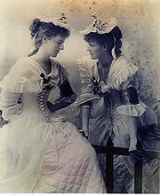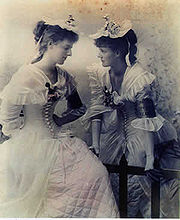
Eva Gore-Booth
Encyclopedia

Lissadell House
Lissadell House is a neo-classical Greek revivalist style country house, located in County Sligo, Ireland.The house was built in the 1830s for Sir Robert Gore-Booth, 4th Baronet MP by London architect Francis Goodwin...
, County Sligo, the younger sister of Constance Gore-Booth, later known as the Countess Markievicz.
Both she and Constance, who later became a prominent Irish
Irish people
The Irish people are an ethnic group who originate in Ireland, an island in northwestern Europe. Ireland has been populated for around 9,000 years , with the Irish people's earliest ancestors recorded having legends of being descended from groups such as the Nemedians, Fomorians, Fir Bolg, Tuatha...
revolutionary, reacted against their privileged background and devoted themselves to helping the poor and disadvantaged.
In 1895, Eva became seriously ill with threatened tuberculosis
Tuberculosis
Tuberculosis, MTB, or TB is a common, and in many cases lethal, infectious disease caused by various strains of mycobacteria, usually Mycobacterium tuberculosis. Tuberculosis usually attacks the lungs but can also affect other parts of the body...
. In the following year, while convalescing in Italy, she met and fell in love with Esther Roper
Esther Roper
Esther Roper was an English suffragist who was one of the first women to graduate and gain her BA at Owens College in Manchester.Esther was the daughter of a Manchester factory worker who later became a missionary in Africa....
at the villa of Scottish writer George MacDonald
George MacDonald
George MacDonald was a Scottish author, poet, and Christian minister.Known particularly for his poignant fairy tales and fantasy novels, George MacDonald inspired many authors, such as W. H. Auden, J. R. R. Tolkien, C. S. Lewis, E. Nesbit and Madeleine L'Engle. It was C.S...
. Esther Roper
Esther Roper
Esther Roper was an English suffragist who was one of the first women to graduate and gain her BA at Owens College in Manchester.Esther was the daughter of a Manchester factory worker who later became a missionary in Africa....
was the daughter of Edward Roper, a factory hand who later became a Missionary, and Annie Roper the daughter of Irish immigrants. Esther identified as half Irish. By 1896 Esther had been secretary of the North of England Society for Women's Suffrage for four years.
Eva returned briefly to her home at Lissadell and established a Sligo branch of the Irish Women’s Suffrage and Local Government Association. Within months Eva rejected her privileged lifestyle and went to live in Manchester with Esther. They later became joint secretaries of the Women's Textile and Other Workers Representation Committee.
In 1916 Eva and Esther established a radical journal entitled 'Urania,' which expressed their pioneering views of gender and sexuality.
In the aftermath of the 1916 Rising she was instrumental in the campaign to secure the reprieve of her sister who had been sentenced to death for her involvement. Along with Alice Stopford Green
Alice Stopford Green
Alice Stopford Green was an Irish historian and nationalist.She was born Alice Sophia Amelia Stopford in Kells, County Meath. Her father Edward Adderley Stopford was Rector of Kells and Archdeacon of Meath. Her paternal grandfather was the Church of Ireland Archbishop of Meath...
she also took part in the unsuccessful campaign for the reprieve of Roger Casement
Roger Casement
Roger David Casement —Sir Roger Casement CMG between 1911 and shortly before his execution for treason, when he was stripped of his British honours—was an Irish patriot, poet, revolutionary, and nationalist....
.
Eva was also an accomplished poet. Her first published volume was highly praised by Yeats
Yeats
W. B. Yeats was an Irish poet and playwright.Yeats may also refer to:* Yeats ,* Yeats , an impact crater on Mercury* Yeats , an Irish thoroughbred racehorse-See also:...
. After World War I
World War I
World War I , which was predominantly called the World War or the Great War from its occurrence until 1939, and the First World War or World War I thereafter, was a major war centred in Europe that began on 28 July 1914 and lasted until 11 November 1918...
, Eva and Esther became members of the Committee for the Abolition of Capital Punishment and worked for prison reform.
As she grew older, Eva was forced to give up active work but continued writing poetry. Esther took care of her throughout her long illness and they were together at the end. Eva died in 1926 at her home in Hampstead
Hampstead
Hampstead is an area of London, England, north-west of Charing Cross. Part of the London Borough of Camden in Inner London, it is known for its intellectual, liberal, artistic, musical and literary associations and for Hampstead Heath, a large, hilly expanse of parkland...
, London
London
London is the capital city of :England and the :United Kingdom, the largest metropolitan area in the United Kingdom, and the largest urban zone in the European Union by most measures. Located on the River Thames, London has been a major settlement for two millennia, its history going back to its...
.
After Eva's death, Esther collected many of her poems for publication and wrote a biographical introduction to them. Esther was extremely reticent, and little is known of her final years. Constance wrote of her: "The more one knows her, the more one loves her, and I feel so glad Eva and she were together, and so thankful that her love was with Eva to the end."
Sources
- Gifford Lewis, ‘Booth, Eva Selina Gore- (1870–1926)’, Oxford Dictionary of National Biography, Oxford University Press, 2004 accessed 29 July 2006
External links
- Eva (Selina) Gore-Booth at www.pgil-eirdata.org

